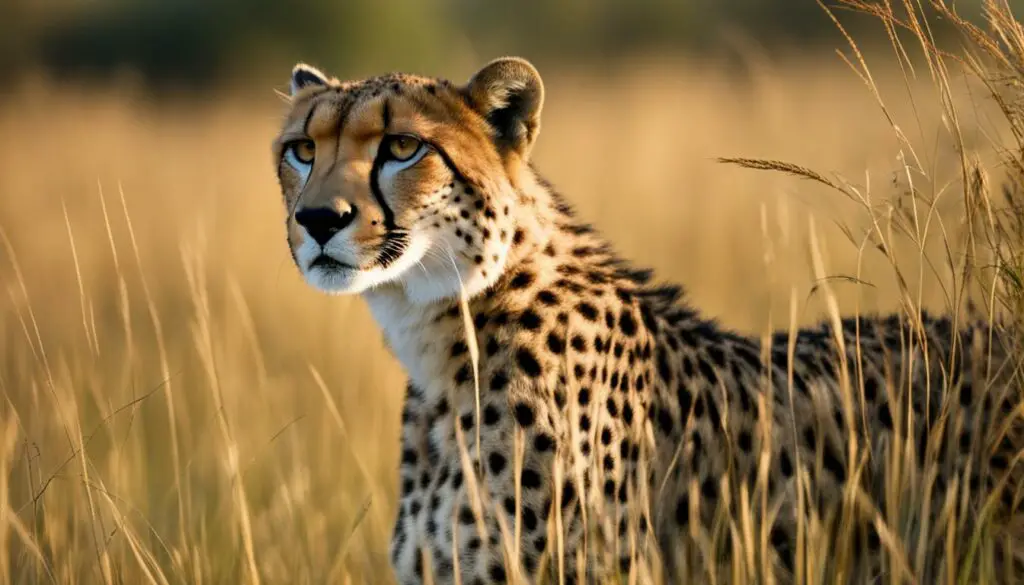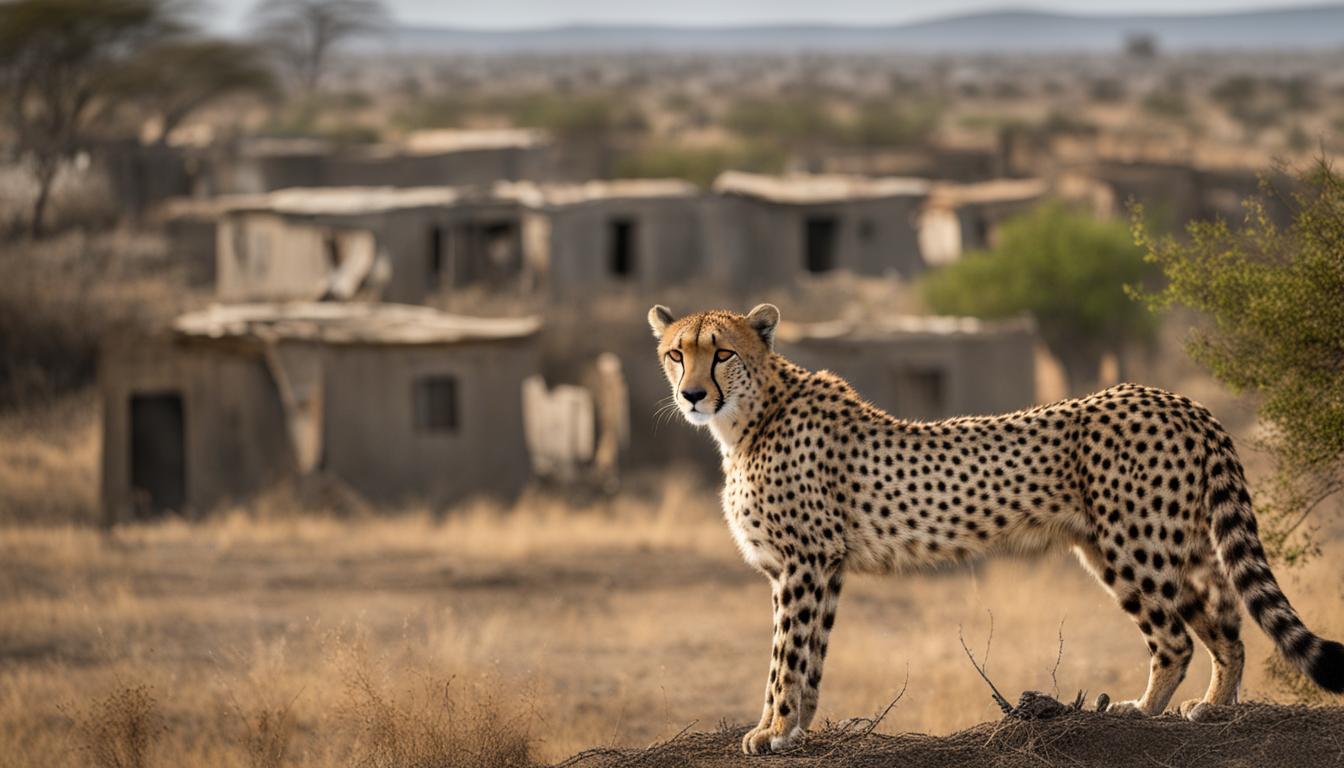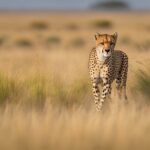Cheetahs, known for their incredible speed and agility, are facing a decline in populations due to various threats. One significant factor contributing to this decline is the conflict between humans and cheetahs. As human populations continue to grow and encroach upon cheetah habitats, conflicts arise, resulting in detrimental consequences for cheetah populations.
Human-wildlife conflicts often lead to cheetahs being killed or captured, further exacerbating their already dwindling numbers. Activities such as hunting and habitat destruction, driven by human actions, coupled with the cheetah’s low reproductive rate and genetic bottleneck events, have collectively contributed to a significant decline in cheetah populations over the past few decades.
It is crucial to understand the impact of cheetah-human conflicts on cheetah populations in order to develop effective conservation strategies and mitigate these conflicts. By addressing the underlying causes of conflicts and promoting coexistence between humans and cheetahs, we can work towards safeguarding the future of these magnificent creatures and ensuring their populations thrive once again.
The Evolutionary Challenges and Genetic Bottlenecks of Cheetahs
Cheetahs have faced numerous challenges throughout their evolutionary history, contributing to their unique genetic makeup and vulnerabilities. One theory suggests that cheetahs descended from a common ancestor with the American puma, highlighting their fascinating evolutionary journey. However, around 10,000 to 12,000 years ago, a catastrophic extinction event occurred, leading to the demise of cheetah populations in North America and Europe. This event resulted in genetic bottlenecks, severely limiting the genetic variability of cheetahs we see today.
The genetic bottlenecks experienced by cheetahs have profound implications for their survival. With limited genetic diversity, cheetah populations struggle to adapt to changes in their environment and are more susceptible to diseases. Inbreeding becomes a prevalent issue, leading to various consequences such as asymmetrical skull development and high homozygosity rates. These genetic challenges pose significant obstacles for cheetahs, hindering their ability to thrive in the face of human-driven habitat loss and other stressors.
“The genetic bottlenecks experienced by cheetahs have profound implications for their survival.”
Genetic Variability and Conservation Efforts
The low genetic variability of cheetahs reinforces the urgency of conservation efforts to protect this iconic species. Conservationists recognize the importance of preserving remaining genetic diversity and implementing strategies to mitigate the risks associated with genetic bottlenecks. Initiatives such as captive breeding programs aim to maintain and increase genetic variability within cheetah populations, reducing the negative effects of inbreeding and enhancing overall population fitness.
To further safeguard the genetic health of cheetahs, collaboration between conservation organizations, researchers, and governments is essential. Through scientific research and genetic monitoring, experts can develop targeted management and conservation strategies that address the specific needs of different cheetah populations. By prioritizing genetic diversity in conservation efforts, we can help ensure a more resilient future for cheetahs and promote their long-term survival.
| Population | Genetic Diversity | Inbreeding Level |
|---|---|---|
| African Cheetahs | Moderate | Low |
| Iranian Cheetahs | Low | High |
| Asian Cheetahs | Extremely low | Very high |
Factors Contributing to Cheetah Population Decline
Human-wildlife conflict, habitat loss, prey decline, and the illegal wildlife trade are all significant factors contributing to the decline of cheetah populations.
Human-wildlife conflict poses a significant threat to cheetah populations. As human populations expand and encroach upon cheetah habitats, conflicts arise. Farmers who view cheetahs as a threat to their livestock often kill or trap them. These encounters not only result in direct cheetah mortalities but also disrupt their natural behaviors and ability to find food and shelter.
Habitat loss is another major driver of cheetah population decline. Human activities, such as farming, development, and infrastructure expansion, lead to the destruction and fragmentation of cheetah habitats. This reduction in available land constrains cheetah movements, hampers their ability to find suitable prey, and limits their reproductive success.
“The conflict between humans and cheetahs often leads to dire consequences for the cheetahs. Farmers who perceive cheetahs as a threat to their livelihoods take drastic measures to protect their livestock, resulting in the indiscriminate killing of cheetahs. This conflict further exacerbates the already precarious situation of cheetah populations.”
The decline in prey species also contributes to cheetah population decline. Cheetahs primarily rely on abundant populations of prey species, such as Thomson’s gazelle, for survival. However, habitat loss, overhunting, and competition with livestock for grazing land have caused a decline in these prey populations. As a result, cheetahs struggle to find enough food to sustain themselves and their offspring, leading to malnutrition and decreased reproductive success.
Lastly, the illegal wildlife trade poses a grave threat to cheetah populations. Cheetahs are often targeted for their skins, which are highly valued in the fashion industry, or they are captured and sold as exotic pets. This illegal trade not only directly affects cheetah populations but also fuels the ongoing exploitation and endangerment of other wildlife species.
| Factor | Impact on Cheetah Population |
|---|---|
| Human-wildlife conflict | Direct killing or trapping of cheetahs, disruption of natural behaviors, and reduced access to food and shelter |
| Habitat loss | Restricted movements, limited access to prey, and decreased reproductive success |
| Prey decline | Malnutrition, decreased reproductive success, and reduced population numbers |
| Illegal wildlife trade | Direct threats to cheetah populations through poaching and capture for skins and the exotic pet trade |
Cheetah Conservation and Promoting Coexistence
Conservation efforts play a vital role in mitigating the conflicts between humans and cheetahs while striving to protect and preserve cheetah populations. These efforts focus on conflict resolution strategies, promoting coexistence, and sustainable development initiatives that aim to address the underlying causes of human-cheetah conflicts and minimize their impact. By working together, we can ensure a future where both humans and cheetahs can thrive.
Conflict Resolution Strategies
One key aspect of cheetah conservation is implementing conflict resolution strategies that foster understanding and cooperation between humans and cheetahs. These strategies involve improving livestock protection measures to reduce predation, such as reinforced enclosures and deterrents, to minimize economic losses for farmers. Additionally, compensation programs can be established to alleviate the financial burden of livestock depredation, providing an incentive for farmers to support cheetah conservation efforts.
Education and awareness programs are also crucial in promoting conflict resolution. By educating local communities about the ecological importance of cheetahs and the benefits of coexistence, we can build empathy and encourage positive attitudes towards these majestic creatures. This can lead to greater acceptance and support for conservation initiatives.
Promoting Coexistence
Promoting coexistence between humans and cheetahs involves finding sustainable solutions that benefit both parties. This includes creating wildlife corridors and protected areas that allow cheetahs to safely traverse their habitats without coming into direct contact with humans. By designating suitable spaces for cheetahs to roam and hunt, we can minimize conflicts and protect their natural behaviors.
Engaging local communities is crucial to ensuring the success of promoting coexistence. By involving communities in decision-making processes, creating economic opportunities through ecotourism initiatives, and facilitating dialogue between stakeholders, we can foster a sense of ownership and shared responsibility for cheetah conservation. This collaboration is essential in creating a future where humans and cheetahs can peacefully coexist.
| Conservation Efforts | Key Objectives |
|---|---|
| Conflict Resolution Strategies | – Improve livestock protection measures – Establish compensation programs – Educate communities |
| Promoting Coexistence | – Create wildlife corridors and protected areas – Engage local communities – Facilitate dialogue and collaboration |
| Sustainable Development Initiatives | – Balance human needs with wildlife conservation – Support economic opportunities through ecotourism – Integrate conservation into land use planning |
Sustainable Development Initiatives
Sustainable development initiatives are crucial for addressing the root causes of human-cheetah conflicts and ensuring long-term conservation success. By finding a balance between human needs and wildlife conservation, we can create a sustainable future for both. This involves integrating conservation into land use planning, promoting responsible agricultural practices, and supporting economic opportunities that benefit local communities.
One effective approach is the integration of cheetah conservation into eco-tourism initiatives. By creating opportunities for wildlife viewing and eco-lodges, we can generate income for local communities while raising awareness about the importance of conserving cheetah habitats. This can help shift the narrative from viewing cheetahs as threats to appreciating them as valuable assets for the region.
Furthermore, sustainable development initiatives prioritize the preservation and restoration of cheetah habitats. This includes reforestation efforts, conservation of natural resources, and promoting sustainable farming practices that minimize habitat destruction. By safeguarding cheetah habitats, we can provide them with the necessary space and resources to thrive, reducing the likelihood of conflicts with humans.
In conclusion, cheetah conservation efforts focus on conflict resolution strategies, promoting coexistence, and sustainable development initiatives. By addressing the underlying causes of human-cheetah conflicts and working together towards a shared vision, we can protect cheetah populations and ensure their survival for generations to come.

Conclusion
Wildlife conservation plays a crucial role in mitigating cheetah-human conflicts and safeguarding cheetah populations. With their habitats threatened by human activities and their lives at risk due to conflicts, cheetahs face an uphill battle for survival. Nevertheless, through concerted efforts and sustainable development initiatives, we have the opportunity to make a positive impact.
Cheetah populations are highly vulnerable due to habitat loss, decline in prey numbers, and the illegal wildlife trade. These factors, combined with conflicts with humans, have pushed cheetahs to the brink. However, by prioritizing wildlife conservation, we can protect their remaining habitats, preserve their natural prey base, and disrupt the criminal networks driving the illegal trade in cheetahs.
It is essential to adopt conflict resolution strategies that address the underlying causes of conflicts, promote coexistence between humans and cheetahs, and provide support to communities affected by cheetah predation. By implementing measures such as improved livestock protection and compensation programs for farmers, we can reduce conflicts and foster a sense of shared responsibility for cheetah conservation.
Our collective efforts must focus on sustainable development initiatives that strike a balance between human needs and wildlife conservation. By engaging local communities, implementing responsible land-use practices, and advocating for policies that protect cheetah habitats, we can create a future where cheetah populations thrive and people can coexist harmoniously with these magnificent animals.
Are Human-Wildlife Conflicts Similar for Cheetahs and Leopards in terms of Impact on Population?
Human-wildlife conflicts pose a significant threat to both cheetah and leopard populations. The key conservation efforts for leopards, such as establishing protected habitats and mitigating human-wildlife conflicts, can also benefit cheetahs. By addressing these challenges, we can help ensure the survival of both species in the wild.
Are there any similarities in the impact of human-wildlife conflicts on different animal populations?
The impact of kangaroo conflicts on different animal populations varies depending on the specific species involved. Some animals may experience similar disruptions in their natural behaviors and habitats, while others may be less affected. Understanding these similarities and differences can help inform effective conservation strategies for all wildlife.
FAQ
How do human-cheetah conflicts impact cheetah populations?
Human-cheetah conflicts have a significant impact on cheetah populations, contributing to their decline. These conflicts often result in cheetahs being killed or captured, further reducing their already dwindling numbers.
What are the evolutionary challenges and genetic bottlenecks of cheetahs?
Cheetahs have faced multiple challenges throughout their evolutionary history. An extinction event around 10,000 to 12,000 years ago resulted in genetic bottlenecks, limiting the genetic diversity of cheetah populations. This low genetic variability impairs their ability to adapt to changing environments and increases their susceptibility to diseases.
What factors contribute to cheetah population decline?
Several factors contribute to the decline of cheetah populations. These include human-wildlife conflict, habitat loss due to human activities, prey decline, and the illegal wildlife trade.
What conservation efforts are being made to mitigate cheetah-human conflict?
Conservation organizations and initiatives are working to mitigate cheetah-human conflicts. Conflict resolution strategies aim to address the underlying causes of conflicts, and sustainable development initiatives are being implemented to balance human needs with wildlife conservation.
What can we do to preserve cheetah populations and promote coexistence with humans?
By supporting wildlife conservation efforts, implementing conflict resolution strategies, and promoting sustainable development initiatives, we can work towards a future where cheetahs can thrive in their natural habitats.











